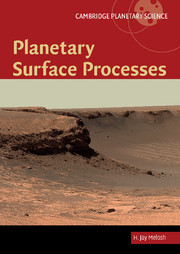7 - Regoliths, weathering, and surface texture
Published online by Cambridge University Press: 05 June 2012
Summary
It is generally accepted that the dynamic nature of the [lunar] regolith is primarily the result of meteoritic bombardment. Although other contributing mechanisms have been suggested (e.g. electrostatic levitation …) the formation of agglutinates, breccias, diaplectic glasses, and the presence of significant contamination of the regolith with meteoritic material are collectively unambiguous evidence in support of the dominant role meteoritic impact has played in regolith evolution.
Gault et al. (1974)Lunar and asteroid regoliths: soil on airless bodies
Impact pioneer Gene Shoemaker and his colleagues introduced the modern concept of a planetary regolith in 1967 (Shoemaker et al., 1967). Following the first soft landing on the Moon’s surface by the Russian probe Luna 9 in 1966, Surveyors 1, 3, and 5 were the first successful landers of the American Surveyor program. Detailed analysis of their images by Shoemaker’s team was the first step toward clarifying the nature of an airless planetary body’s surface. Geologist R. B. Merrill had coined the word “regolith” in 1897 to designate the fragmental layer of rock debris that mantles the Earth’s surface. Compounded from the Greek words for “blanket” (rhegos) and “stone” (lithos), the word had become obsolete by 1967, allowing Shoemaker to revive it in the context of the Moon’s surface.
Although the lunar surface layer is sometimes referred to as “lunar soil,” it is utterly different from the familiar agricultural soil of the Earth. Terrestrial soils typically contain large amounts of organic carbon and weathered rock material that has been transported by wind or water. Living organisms play a major role in creating Earth’s soil layers. In contrast, the lunar surface is blanketed by a loose breccia composed of broken, angular rock fragments that range in size from fine, submicron dust to meter-sized blocks. The lunar regolith has never been disturbed by wind, water, or organic life. Instead, it is created and maintained by the steady hail of meteoritic debris and radiation from open space (Figure 7.1).
- Type
- Chapter
- Information
- Planetary Surface Processes , pp. 276 - 318Publisher: Cambridge University PressPrint publication year: 2011
- 2
- Cited by

